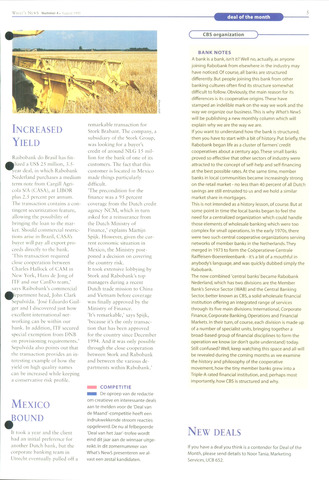Increased
Yield
Mexico
New deals
JIOUND
WHAT'S NEWS Nummer 4 August 1995
deal of the month
5
CBS organization )-
Raibobank do Brasil has fin-
fcli/.ed a US$ 25 million, 3.5-
ytzï deal, in which Rabobank
Nederland purchases a medium
term note from Cargill Agri-
cola S/A (CASA), at LIBOR
plus 2.5 percent per annum.
The transaction contains a con
tingent securitization feature,
allowing the possibility of
bringing the loan to the mar-
ket. Should commercial restric-
tions arise in Brazil, CAS A's
buyer will pay all export pro-
ceeds directly to the bank.
'This transaction required
close cooperation between
Charles Hallock of CAM in
New York, Hans de Jong of
ITF and our CanDo team,'
says Raibobank's commercial
Bepartment head, John Clark
Sepulvéda. 'José Eduardo Guil-
ger and I discovered just how
excellent international net-
working can be within our
bank. In addition, ITF secured
special exemption from DNB
on provisioning requirements.'
Sepulvéda also points out that
the transaction provides an in-
teresting example of how the
yield on high quality names
can be increased while keeping
a conservative risk profile.
It took a year and the cliënt
had an initial preference for
another Dutch bank, but the
corporate banking team in
Utrecht eventually pulled off a
remarkable transaction for
Stork Brabant. The company, a
subsidiary of the Stork Group,
was looking for a buyer's
credit of around NLG 15 mil
lion for the bank of one of its
customers. The fact that this
customer is located in Mexico
made things particularly
difficult.
'The precondition for the
finance was a 95 percent
coverage from the Dutch credit
agency NCM, which in turn
asked for a reinsurance from
the Dutch Ministry of
Finance,' explains Martijn
Spijk. However, given the cur-
rent economie situation in
Mexico, the Ministry post-
poned a decision on covering
the country risk.
It took extensive lobbying by
Stork and Rabobank's top
managers during a recent
Dutch trade mission to China
and Vietnam before coverage
was finally approved by the
Ministry of Finance.
'It's remarkable,' says Spijk,
'because it's the only transac
tion that has been approved
for the country since December
1994. And it was only possible
through the close cooperation
between Stork and Rabobank
and between the various de-
partments within Rabobank.'
COMPETITIE
HB De oproep van de redactie
om creatieve en interessante deals
aan te melden voor de 'Deal van
de Maand'-competitie heeft een
indrukwekkende stroom reacties
opgeleverd. De nu al felbegeerde
'Deal van het Jaar'-trofee wordt
eind dit jaar aan de winnaar uitge
reikt. In dit zomernummer van
What's NewS presenteren we al
vast een zestal kandidaten.
BANK NOTES
A bank is a bank, isn't it? Well no, actually, as anyone
joining Rabobank from elsewhere in the industry may
have noticed.Of course, all banks are structured
differently. But people joining this bank from other
banking cultures often find its structure somewhat
difficult tofollow.Obviously.the main reason for its
differences is its cooperative origins.These have
stamped an indelible mark on the way we work and the
way we organize our business.This is why What's NewS
will be publishing a new monthly column which will
explain why we are the way we are.
If you want to understand how the bank is structured,
then you have to start with a bit of history. Put briefly, the
Rabobank began life asa cluster of farmers'credit
cooperatives about a century ago.These small banks
proved so effective that other sectors of industry were
attracted to the concept of self-help and self-financing
at the best possible rates. At the same time, member
banks in local communities became increasingly strong
on the retail market - no less than 40 percent of all Dutch
savings are still entrusted to us and we hold a similar
market share in mortgages.
This is not intended as a history lesson,of course. But at
some point in time the local banks began to feel the
need for a centralized organization which could handle
those elements of wholesale banking which were too
complex for small operations. In the early 1970s,there
were two such central cooperative organizations serving
networks of member banks in the Netherlands.They
merged in 1973 to form the Coöperatieve Centrale
Raiffeisen-Boerenleenbank- it's a bit of a mouthful in
anybody's language,and was quickly dubbed simply the
Rabobank.
The now combined 'central banks' became Rabobank
Nederland, which has two divisions are the Member
Bank's Service Sector (WAB) and the Central Banking
Sector, better known as CBS, a solid wholesale financial
institution offering an integrated range of services
through its five main divisions: International, Corporate
Finance, Corporate Banking, Operations and Financial
Markets. In their turn, of course, each division is made up
of a number of specialist units, bringing togethera
broad-based group of financial disciplines to form the
operation we know (or don't quite understand) today.
Still confused? Well, keep watching this space and all will
be revealed during the coming months as we examine
the history and philosophy of the cooperative
movement, how the tiny member banks grew into a
Triple-A rated financial institution, and, perhaps most
importantly, how CBS is structured and why.
If you have a deal you think is a contender for Deal of the
Month, please send details to Noor Tania, Marketing
Services, UCB 652.

